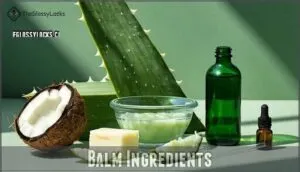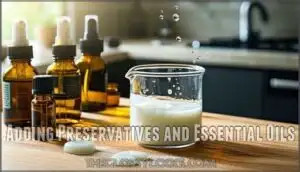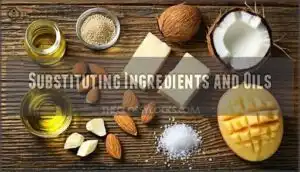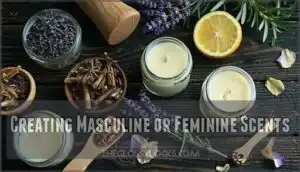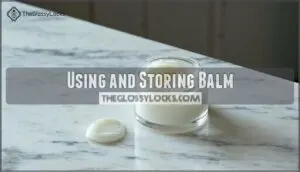This site is supported by our readers. We may earn a commission, at no cost to you, if you purchase through links.
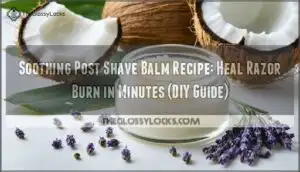 Whip up a soothing post-shave balm with just a few simple ingredients.
Whip up a soothing post-shave balm with just a few simple ingredients.
Melt 2 tablespoons of shea butter and 1 tablespoon of coconut oil over low heat. Stir in 1 tablespoon of aloe vera juice, 1 teaspoon of witch hazel, and 1 teaspoon of grapeseed oil.
Once cooled slightly, add 5 drops of lavender essential oil and 3 drops of tea tree oil for their calming and antibacterial properties.
Pour it into a clean jar and let it set. This balm hydrates, soothes razor burn, and smells amazing—like a spa in a jar. Your skin will thank you for it!
Table Of Contents
- Key Takeaways
- Soothing Balm Benefits
- Balm Ingredients
- Preparation Process
- Customizing Balm Recipe
- Using and Storing Balm
- Frequently Asked Questions (FAQs)
- How to make your own aftershave balm?
- What is the best thing to put after shave?
- What are the ingredients in the best aftershave?
- How long does homemade balm last?
- Can post-shave balm be used daily?
- Does climate affect balm consistency?
- Can I use balm on sensitive skin?
- Should I patch test before full application?
- Conclusion
Key Takeaways
- You’ll need just a few ingredients to make your own post-shave balm: shea butter, coconut oil, aloe vera juice, witch hazel, grapeseed oil, and essential oils like lavender and tea tree.
- Your skin will benefit from multiple healing properties—the balm soothes razor burn, reduces inflammation, helps heal nicks, and provides deep hydration all at once.
- You can easily customize your balm by substituting ingredients (like using mango butter instead of shea) or adjusting essential oils to create masculine, feminine, or seasonal scents.
- You’ll get the best results by applying a pea-sized amount to damp skin after shaving and storing your homemade balm in a cool, dry place away from sunlight for a shelf life of 3-6 months.
Soothing Balm Benefits
You’ll feel instant relief as this homemade balm calms razor burn and seals moisture into your freshly shaved skin.
Its blend of natural ingredients works quickly to reduce redness and irritation, leaving your skin feeling as smooth as a baby’s bottom instead of looking like you’ve wrestled with sandpaper.
Skin Softening Properties
Silk-smooth skin awaits you after shaving with a quality post-shave balm. Your skin deserves special attention after the trauma of a razor.
A good aftershave balm doesn’t just feel nice—it transforms your skin through multiple softening mechanisms.
- Collagen enhancement rebuilds skin’s natural structure
- Humectant action draws moisture into thirsty skin cells
- Lipid barrier restoration prevents moisture loss
- Keratin hydration softens rough patches
- Elasticity improvement gives skin that bounce-back quality
Relief for Shaving Nicks
Those pesky shaving nicks can turn your grooming routine into a painful experience.
Your homemade balm works wonders for immediate soothing and healing. Here’s how it helps:
| Healing Property | Effect on Nicks | Your Benefit |
|---|---|---|
| Aloe Vera | Immediate cooling | Pain relief within seconds |
| Witch Hazel | Stops bleeding | No more tissue patches |
| Shea Butter | Seals wounds | Faster healing time |
| Essential Oils | Reduces irritation | Comfortable skin all day |
Simply apply post-shave for nick-free bliss, utilizing the healing properties of your balm to achieve pain relief and faster healing.
Anti-Inflammatory Effects
Many razor burn sufferers don’t realize their aftershave balm delivers powerful anti-inflammatory effects. Your skin will thank you when natural ingredients calm irritation after shaving.
Post-shave balms offer deep hydration benefits, restoring moisture lost during shaving and preventing dryness.
- Beeswax creates a protective anti-inflammatory barrier without clogging pores
- Sunflower petals reduce redness and calm angry skin naturally
- Witch hazel compounds quickly minimize post-shave inflammation
- Peppermint essential oil cools skin irritation on contact
- Shea butter’s natural properties fight inflammation while healing nicks
Moisturizing and Hydrating Skin
Your skin will drink up the hydration from a quality post-shave balm.
A quality post-shave balm quenches your skin’s thirst, locking in hydration for a smooth, refreshed feel all day long.
The humectant effectiveness of ingredients like glycerin and sodium lactate keeps moisture locked in for hours.
Natural ingredients work overtime to repair your skin barrier function through lipid replenishment.
Even with challenging environmental factors, a soothing balm maintains hydration duration throughout your day.
Your moisturizing balm isn’t just treating razor burn—it’s giving your skin a tall glass of water!
Balm Ingredients
You’ll need just a handful of skin-loving ingredients to create your perfect post-shave remedy that works better than those fancy store-bought options.
The magic combo of shea butter, coconut oil, aloe vera, and witch hazel will soothe your razor-burned skin faster than you can say "smooth as a baby’s bottom.
Shea Butter and Coconut Oil
Shea butter and coconut oil form the heart of your soothing balm.
These powerhouse ingredients work together to heal razor burn fast! Shea butter’s rich lipid composition promotes collagen production while providing natural SPF protection.
Coconut oil locks in moisture with its antibacterial properties.
For the best aftershave balm results, source unrefined, organic versions of both. Can’t find shea? Mango or cocoa butter make excellent alternatives.
Essential Oils and Additives
The right essential oils transform your homemade balm from good to spectacular, offering both aromatherapy and skin benefits.
When selecting additives for your post-shave routine, consider both scent customization and additive safety.
- Lavender and tea tree provide natural antiseptic properties
- Peppermint creates an instant cooling sensation on freshly shaved skin
- Vitamin E oil acts as both preservative and skin nourisher
- Sandalwood or cedarwood deliver masculine scents that linger just right
Consider using a natural essential balm for superior skin soothing.
Aloe Vera Juice and Witch Hazel
Aloe vera juice and witch hazel are like a dream team for your soothing post shave balm.
Aloe vera juice hydrates and calms irritated skin, while witch hazel’s astringent properties reduce redness and tighten pores.
Together, they balance hydration levels and boost product stability.
| Ingredient | Skin Benefits | Astringent Properties | Hydration Levels |
|---|---|---|---|
| Aloe Vera Juice | Soothes and moisturizes | No | High |
| Witch Hazel | Reduces redness | Yes | Moderate |
| Combined Formula | Calms and refreshes skin | Yes | Balanced |
| DIY Balm Use | Post-shave relief | Yes | Ideal |
The combination of aloe vera juice and witch hazel creates a post-shave balm that is both soothing and effective, making it an ideal DIY balm for post-shave relief.
Grapeseed Oil and Emulsifying Wax
While witch hazel and aloe soothe freshly-shaved skin, grapeseed oil takes your DIY post shave balm to the next level.
Packed with linoleic acid and antioxidants, this lightweight oil fights inflammation while moisturizing. Grapeseed oil’s benefits include protection from UV rays.
The magic happens when you add emulsifying wax—it’s the matchmaker that helps water and oil become best friends! Without it, your ingredients would separate like oil on water.
Your skin will thank you for this smooth-absorbing combo.
Preparation Process
You’ll want to prepare your healing post-shave balm in a clean workspace with all ingredients measured and ready to go, just like a TV chef who never scrambles for missing items mid-recipe.
The preparation process isn’t complicated but requires careful attention to temperature and timing, especially when melting your butters and oils before the cooling and whipping stages, which involves careful attention.
Melting and Mixing Ingredients
When you’re ready to create your post-shave balm, proper melting and mixing is the secret to silky-smooth results.
Begin by creating a simple water bath with your mason jar nestled in simmering water.
- Melt shea butter first on low heat to avoid scorching
- Add carrier oils once the butter liquefies completely
- Use an immersion blender for quick emulsification between oil and water phases
- Stir continuously with a silicone spatula to prevent separation
- Follow the ingredient order precisely for proper emulsifying wax activation
Achieving the right consistency often involves careful shea butter melting.
Heating and Cooling Phases
You’ll need to master the dance between hot and cold to create the perfect aftershave balm. The heating and cooling phases are where the magic happens!
| Phase | Temperature | Time |
|---|---|---|
| Oil Phase | Low heat | Until melted |
| Water Bath | Simmering | 5-10 minutes |
| Cool Down | Refrigerator | 15-20 minutes |
Combine your heated water phase with the heated oil phase, then add emulsifying wax. After thorough mixing with an immersion blender, start the chilling process.
Proper technique includes shaving with the grain to minimize irritation. Don’t forget your broad spectrum preservative during cooldown!
Whipping and Blending Techniques
Properly whipping your balm transforms it from a simple mixture into a luxurious treatment.
For perfect emulsification process:
- Use short bursts with an immersion blender rather than continuous blending
- Alternate between whipping and cooling for the ideal thick and creamy texture
- Watch for the "trace" stage when the mixture leaves marks on the surface
- Choose a stand mixer for larger batches or a hand whisk for more control
This process allows for perfect emulsification, resulting in a desirable texture.
Adding Preservatives and Essential Oils
Now that you’ve whipped your balm to perfection, it’s time for the finishing touches.
Let your mixture cool slightly, then add a preservative like Liquid Germall Plus (0.5%) or Vitamin E oil to prevent spoilage.
Mix in 15-20 drops of essential oils per 100ml of base—peppermint for cooling, cedarwood for masculine scents, or sandalwood for soothing properties.
Stir thoroughly to distribute these scent combinations evenly before transferring to your container, ensuring a smooth finish with essential oils.
Customizing Balm Recipe
You’ll love tweaking this balm recipe to make it uniquely yours, whether you’re swapping almond oil for jojoba or adding peppermint for a cool tingle.
Your skin deserves this personal touch, just like how my brother created his "manly mountain" scent by mixing cedarwood and eucalyptus oils that made his bathroom smell like a fancy barbershop, giving it a unique and personal aroma.
Adjusting Essential Oils and Scents
Now that your balm base is prepared, it’s time to personalize it with scents that speak to you! Essential oils do more than just smell nice—they offer unique skincare benefits too.
- Masculine Scents: Combine cedarwood (5 drops), peppermint (4 drops), and vetiver (1 drop) for a woodsy, invigorating aroma
- Feminine Scents: Blend lavender (6 drops), orange (4 drops), and ylang-ylang (2 drops) for a floral, citrusy profile
- Scent Combinations: Mix and match to create your signature blend
- Oil Sensitivities: Always patch test new essential oil blends
- Aroma Benefits: Peppermint soothes irritation while sandalwood calms redness
Substituting Ingredients and Oils
Your recipe’s success doesn’t depend on having every exact ingredient in stock. You can easily swap oils and components while maintaining effectiveness.
Here’s a handy reference for common substitutions:
| Original Ingredient | Possible Substitution |
|---|---|
| Sweet Almond Oil | Jojoba or Apricot Kernel Oil |
| Shea Butter | Mango Butter or Cocoa Butter |
| Coconut Oil | Babassu Oil or Palm Oil |
| Beeswax | Candelilla Wax (vegan option) |
| Emulsifying Wax | Lecithin or Polawax |
Can’t find grapeseed oil? No worries! Sunflower oil works just as well in your DIY aftershave balm, and you can also consider common substitutions to maintain the effectiveness of your recipe with easy swaps.
Creating Masculine or Feminine Scents
Want your post shave balm recipe to smell just right? Play with scent families for a custom vibe!
- Masculine: Blend cedarwood, sandalwood, and vetiver for a rugged, earthy aroma.
- Feminine: Try lavender, rose, and orange for a soft, floral touch.
- Gender-neutral: Go fresh with eucalyptus and peppermint.
- Seasonal: Add warm spices for winter or citrusy notes for summer.
Adding Broad-Spectrum Preservatives
Anyone making water-based balms needs preservatives to prevent unwanted visitors (bacteria and mold).
For your DIY recipe, add 2-4% broad-spectrum preservative based on total weight. Options include Geogard 221 or potassium sorbate for natural alternatives.
A robust system can improve chances of passing preservative efficacy testing.
Follow manufacturer temperature guidelines when mixing them in. Even with preservatives, store your creation properly – microbial growth isn’t just gross, it can cause skin irritation too!
Using and Storing Balm
You’ll get the most from your homemade post-shave balm by applying a pea-sized amount to freshly shaved, slightly damp skin with gentle, upward strokes.
Store your balm in a clean glass jar in a cool, dry place away from direct sunlight to keep it fresh for up to six months, just like how you’d treat your favorite ice cream to prevent it from melting into a sad puddle, and handle it with care to maintain its quality over six months.
Applying Balm After Shaving
After patting your skin mostly dry, apply a small, dime-sized dollop of post shave balm using gentle, circular motions.
You’ll need less than you think! Wait 30 seconds before dressing to let it absorb fully.
For those with skin sensitivity, test on a small area first. Your partner can help apply it to hard-to-reach areas, making postshave care both soothing and intimate.
Storing in Cool and Dry Places
Your homemade post shave balm deserves a cozy home away from direct sunlight.
Store it in a cool, dry cabinet where temperature remains steady—heat can cause separation while excessive cold might solidify your balm.
Glass containers preserve product stability better than plastic, which can leach chemicals.
For maximum shelf life (about 3-6 months), control humidity by keeping lids tightly sealed. Consider using a cool storage solution to maintain ideal conditions.
Remember: proper storage means your skincare recipe stays effective longer!
Maintaining Hygiene and Consistency
Keeping your post shave balm safe starts with good sterilization practices. Use clean tools and containers to dodge contamination.
Label your homemade balm with the date—it’s like a freshness timer! Test small batches to guarantee ingredient freshness and extend shelf life.
For sensitive skin, consider fragrance-free soothing balms. Inspect for changes in texture or smell. Nobody wants spoiled balm—store it cool and dry!
Frequently Asked Questions (FAQs)
How to make your own aftershave balm?
You’ll need shea butter, coconut oil, and olive oil for your DIY aftershave balm.
Melt them together in a water bath, chill until soft, then whip with essential oils like sandalwood or eucalyptus.
What is the best thing to put after shave?
Think of your skin as a freshly painted canvas—it needs care.
After shaving, use an aftershave balm with aloe vera or witch hazel.
It soothes irritation, locks in moisture, and leaves skin feeling refreshed.
What are the ingredients in the best aftershave?
Your best aftershave combines shea butter, aloe vera, witch hazel, and carrier oils like jojoba or sweet almond.
Add vitamin E for healing, and personalize with essential oils like sandalwood or peppermint for scent and extra benefits.
How long does homemade balm last?
Like a trusty friend, your homemade balm typically lasts 3-6 months. Without preservatives, you’ll get about 1-3 months. Store it in a cool, dark place to extend its shelf life.
Can post-shave balm be used daily?
Yes, you can use post-shave balm daily.
Your skin will thank you for the regular moisture and soothing benefits, especially if you’re shaving frequently.
It won’t clog pores when properly formulated.
Does climate affect balm consistency?
Climate definitely affects your balm’s consistency.
Heat softens while cold hardens your creation.
You’ll notice thinner textures in summer and firmer products in winter.
Consider adjusting your recipe seasonally for the best results.
Can I use balm on sensitive skin?
Balms containing shea butter and aloe vera work wonders on sensitive skin.
You’ll find they’re gentle enough to soothe post-shave irritation without stinging.
Just patch test first to confirm you won’t have a reaction.
Should I patch test before full application?
You’ll save yourself a mountain of trouble by doing a quick patch test.
Apply a small amount to your inner wrist, wait 24 hours, and watch for any redness or irritation before going all-in.
Conclusion
Surprisingly, the simplest remedies often work best.
This soothing post shave balm recipe transforms your daily routine into a spa-like experience at a fraction of the cost.
You’ll love how quickly it calms razor burn while nourishing your skin. Keep it on your bathroom shelf for those moments when your face needs extra TLC.
With these natural ingredients working together, you’ve got everything you need for happy, healthy skin. Why not make a batch today?


